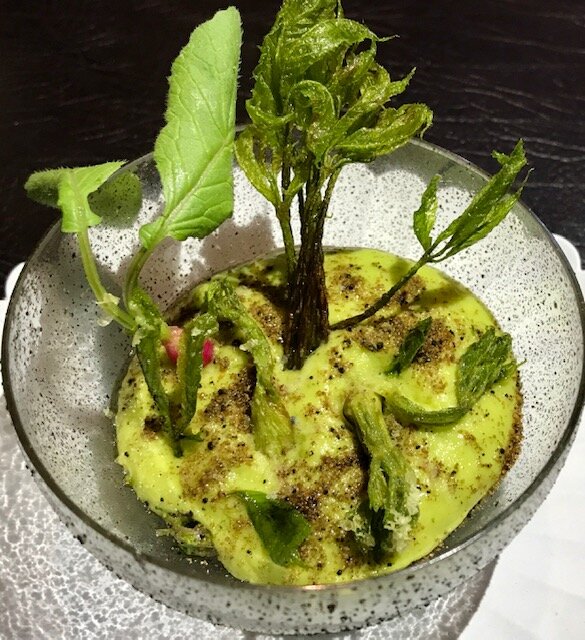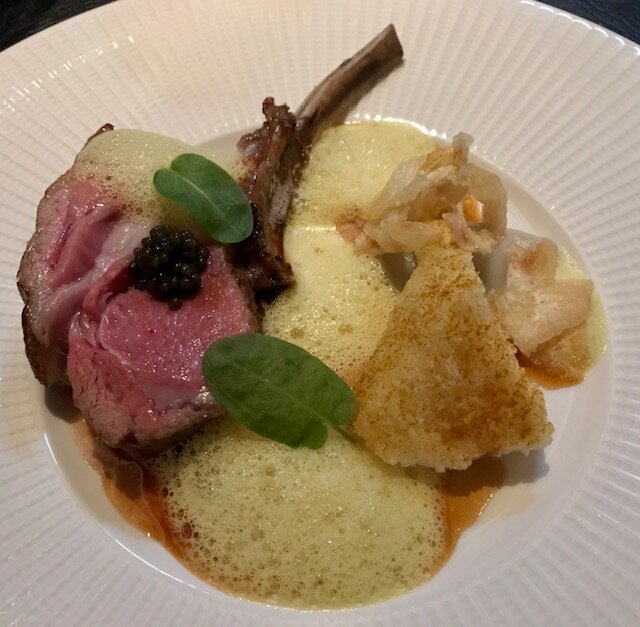May 21, 2021
Caught in an interminable traffic jam, racking up an Uber fee so high that taking a helicopter or chartering a submarine would have been cheaper, you finally stumble into Tirpse with the look of someone who just clambered out the window of a locked ward. Since this is surely a medical emergency, and your insurance covers medications, you order a mango champagne cocktail (HK$178), your wife an Old Fashioned (HK$168). Exemplary versions, delicious, you slowly realign with earth’s magnetic field. You particularly like the artistic care taken to fashion the lemon peel garnishes.
You assumed that Tirpse was a riff on Terpsichore, Goddess of Dance. You learn though, it is “Esprit” backwards, gratifying to one who loves word play (What is “Natasha” backwards?). They serve French-Japanese food by tasting menu only (your five-course dinner, HK$1488). You each order the wine option (five glasses, HK$728). Decelerated finally, in the leisurely act of sipping your cocktails, they pour the first wine, Riesling, Schäfer-Fröhlich, Schiefergestein Bockenauer, Trocken, Nahe 2014. My, Tirpse’s waiters have a spring in their step. Your wife, family sommelier, approvingly picks up a note of petrol (not to be confused with petrel) in the wine. Two amuse bouches are served.
Elegantly plated, the first are small pieces of bright green toast (from parsley infused house-bread) with chopped Sea Bream rimed by minced parsley. The pristine fish is mixed with fish sauce, lime zest juice, Japanese parsley, and coriander. Sauce notwithstanding, it is so mild that your bouche must search for its amuse like trying to pick up weak wifi.
The gazpacho, on the other hand, zings with flavor. You would have happily consumed a large bowl. It is brilliantly accented by salty bits of pistachio. In the middle, bobbing like an ice floe, is a shard of frozen ricotta. It seems clear to you that if any shard is called for, it should be crab or lobster or shrimp. Maybe some kind of roe. Ricotta is too mild. And freezing it, while clever, suppresses its flavor even more.
Both your waiter and the sommelier it seems are committed to keeping the trains moving on schedule. Your dishes are whisked away and a starter of avocado foam, firefly squid, and wild garlic arrives. The sommelier pours a glass of Jumai Ginjo, by Urakasumi N.V. HEAVENSAKE. You’re no sake fan, but you like this enough to think that maybe you could be. You gulp the remains of your cocktail and first glass of wine to help clear the decks. And you swig your wife’s cocktail. She’s a slowpoke and this is what she gets for it. This pattern of service moving from course to course at a slightly swifter pace than your own continues throughout the meal.
Since Tirpse is part French, it’s worth noting that the French word for avocado, “avocat,” has two meanings. One is avocado. The other is lawyer. So the foam in this dish could be based on pureed lawyer. Pureed lawyer is notoriously dry and unpleasant though and then they sue you. So you’re fairly certain it’s avocado. An interesting edible garden of minty Kinome leaves (from the Szechuan Pepper Tree) and what looks like a micro-radish projects from the surface. You can taste no garlic, let alone wild garlic, at all. The firefly squid hidden within are startlingly delicious. Never before have you had squid so squiddy. You love them. There are just a few, not nearly enough, within the thick avocado foam. You have to probe for them with your fork just as rescuers probe for avalanche victims. The foam, flavored with fish sauce and lime juice, is good but nowhere near life-altering. In your view, it’s actually an impediment, obscuring the squids’ delicate flavor. You think they should have skipped the avocado foam altogether and really put the squid (lots more of them) front and center. Grilling them over charcoal and serving them with just a beurre blanc, with Japanese flavoring perhaps, would have been one way to do this.
The blue lobster in the Lobster, Sichuan Pepper, Seaweed is cooked perfectly, sweet, deep, pure. Since lobster is commonly overcooked, this is a rare delight. The setting for this gem is an edible green garden with quenelles of broccoli puree and seaweed puree. Quite pretty, the garden doesn’t do much to enhance or amplify the lobster itself. It’s almost an omnipurpose garden into which they might have dropped any protein. Broccoli is an affable gent, but by your lights not a great marriage partner for lobster. And though the seaweed is from the lobster’s ‘hood, and congenial by itself, you think it’s also matrimonially weak. Apparently Sichuan Peppercorn flavors little dabs of oil on the plate. You did not taste it at all. Perhaps if you had purposefully searched for it you would have.
Kinmedai, a Japanese fish, is steamed in sake and kombu (kelp) perfectly au point, fresh, nummy. It rests upon a bitter vegetable you’ve never before had and that you enjoy, butterbur. A lot of a fish’s flavor is in its skin. You think that sautéing it – crisping and intensifying the skin’s flavor – would have made the dish stronger yet. It comes in a transparent sauce of kombu, ginger, and clams which tastes distinctively oceanic, like savory sea-water. You like it, not enough though for its flavor to haunt you days later.
You can smell the yeasty-steam of the housemade, hot ciabatta before it arrives. The butter – actually a mixture of brown butter, butter, sour cream – is audaciously delicious. Upon the ciabatta, the effect is boggling pleasure. You order a second round. Only your wife’s unblinking gaze stops you from ordering a third and a fourth. You eye other tables for this bread and contemplate the possibility of mounting your own Entebbe raid to get them. However, landing a souped-up Israeli Air Force C-130 Hercules, a duplicate of Idi Amin’s personal Mercedes limo, and a hundred commandos within the confines of the restaurant is too much.
Your wife orders lamb, you Wagyu (HK$268 upcharge), for mains. Both are cooked perfect medium rare and are delicious. Consider how much less delicious duck or chicken (or turkey or goose) would be with uncrisped skin. In like manner, beef and lamb are diminished without significant exterior char. You think of New Punjab Club’s mythic tandoori’d lamb or Artemis & Apollo’s charcoaled chops. The caramelized, not-quite-burnt, crust amps their flavor. Since the lamb was cut from a rack, it has little of this. The beef has more, but not as much as you crave.
The artichoke with the lamb (cooked sous vide and then fried) is sublime (you’ve made this dish many times without sous vide and don’t understand why they felt the need to use it). There’s a dollop of caviar on the chop which baffles you, a complete non-sequitur. It makes no more sense than a dollop of caviar on a BLT. All you can figure is it’s there to badge the dish, and by extension the restaurant, as luxe, like adding a Gucci logo. It’s served with lamb jus and a foam comprised of shallot, garlic, turmeric powder, vegetable soup, butter and cream which is good but not in proportion to the number of ingredients.
The beer sauce with the beef, from beef jus and black beer, is tasty enough, but lacks the depths of any number of French demi-glace-based sauces such as a classic Bordelaise. You would have enjoyed a Béarnaise, which always punches way above weight, more. Any of these sauces could have been given a Japanese tilt if desired.
They bring a Chenin Blanc, Domaine Huet-L’Echansonne, Le Mont, Premiere Trie, Moelleux, Vouvray 2008 to go with dessert. It is by far your favourite wine of the evening with dulcet tones of raisin and honey.
You have their Strawberry, Rhubarb, Sansho Pepper dessert. It consists of strawberries marinated with housemade rhubarb jam, raspberry-syrup in a coconut-lemon-lime-orange custard, cloaked in meringue and milk foam. It is delicious. You particularly like the textural elements of the milk foam and the meringue against the fruit. Your tongue lacked the sensitivity to distinguish the tastes of lemon zest, lime zest, orange zest from each other or, for that matter, the rhubarb and raspberry from the strawberry. It could well be five glasses of wine dulled your palate. Or, could it be that a long queue of similar ingredients in the same dish lose their distinctiveness?
Your wife has Hyuganatsu, Honey, Crème D’anjou. Hyuganatsu is a kind of Japanese orange and translates as New Summer Orange. Its membrane-free slices are artfully mixed with mead (honey wine, which your fellow college students used to bootleg), yogurt sorbet, turmeric-scented tuilles and Crème d’Anjou (sweetened fromage blanc). Unique, like the strawberry dessert, you love it.
The meal finishes with a Petit Four Treasure Chest, a lovely wooden display box, alluringly decorated as a forest glade, showcasing five sets of dainties. All were nice, but only the caramels gave you a solid dopamine hit.
Excellent cappuccino followed.
Wrought by an artist’s hand, Tirpse is among the most beautiful restaurants you’ve visited in Hong Kong. It has a riveting harbor view. Junks slide by silently, as in a dream, lit like paper lanterns. Service is excellent, chairs pushed and pulled, napkins replaced, crumbs swept. There is a slight sense of hurry-up though. Both plates and wine were continually swept away and replenished just a little before you and your wife were quite ready as though the staff were trying to move you along, as though they had promises to keep and miles to go before they sleep. You couldn’t tell if it was a conscious policy of the restaurant, maybe to open your table for the next customers, or simply the waitstaffs’ forward-lean. Or conceivably it’s your imagination, though your wife, Intuition’s favorite daughter, picked up on it as well.
You liked the simple dishes best. The bread was fabulous. The butter was fabulous. The gazpacho was fabulous. The desserts, more complex, were fabulous. You could happily live on those dishes. You liked components of other dishes -- such as the lobster, beef, lamb, and artichoke – very much. Every single dish was cooked perfectly, fish au point, meats medium rare, vegetables just past raw.
Above all else, when a diner tastes anything in a restaurant of this caliber, their jaw should drop, their heartbeat should surge, their toes curl. The food should be so delicious that they must suppress the urge to chortle. By comparison, it hardly matters from which planet a restaurant sources its fish or whether or not it’s cooked over sustainably harvested lava. Taste is paramount.
All of Tirpse’s dishes were remarkably complex in terms of ingredients and cooking technique. There were clever touches everywhere. There were ample prestige ingredients. Ample exotic ingredients. Yet, for all this you were only gobsmacked by some of the dishes. Only some of the food for you was OMG delish. It’s as though the kitchen was so absorbed in cleverness and caviar and complexity that sometimes it lost sight of its end goal: taste. This resulted in some items that were,
a/ puzzling (the avocado-squid), or
b/ mismatched (the lobster-broccoli), or
c/ pretentious (the caviar on the lamb), or
d/ ineffectively clever (the frozen ricotta), or
e/below their flavor potential (the lamb, beef and Kinmedai sauces).
All of Tirpse’s cuisine utterly delights the eye. Much of their food utterly delights the tongue. The rest, with minor reset, could certainly do so.
Rating (on a scale of 0 to 5)
Food overall: 3.5
Ambience: 5
Service: 4
Overall greatness: 3.5
Restaurants are intuitively rated within their particular realms. So Michelin restaurants, pizza places and stand-up sandwich joints are judged against like restaurants, not each other. A 5 for a high-end restaurant is not meant to be the same as a 5 for street food.
From my website, here’s how I rate food: “I believe the quality of a restaurant’s food is vastly more important than any other factor. Even if I love a restaurant’s food, I’m very conservative about giving out 4’s or 5’s. I reserve 4’s for food that is uniformly excellent. Preponderantly excellent tends to get a lower score. 5’s are for food that is uniformly stunning.”
This meal was comped.
Tirpse
K11 MUSEA, Unit #219, 18 Salisbury Rd, Tsim Sha Tsui, Hong Kong













